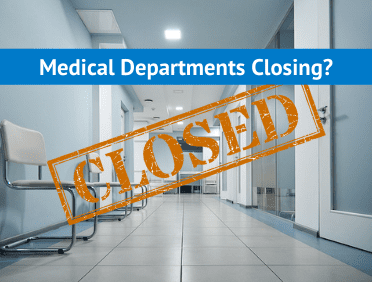
The strain of COVID-19 is one of many reasons why medical departments in hundreds of at-risk hospitals, nationwide, have closed, moved or ended services. There also is a shift away from inpatient hospital stays toward alternative care settings that is contributing to the financial strain for health systems nationwide. As the industry shifts toward care delivery at home, virtually or in other outpatient settings, some providers are changing gears in terms of the services they offer or turning to merger and acquisition to be better equipped to meet the market demands. While the main drivers behind most shifts is finances, saving resources and focusing more on in-demand services is key.
At the time of a medical department or hospital closure or acquisition, one question is how to best retain access to patient, employee, and business records.
What are the record retention rules for protected health information (PHI) during a medical department or hospital closure?
HIPAA covered entities must keep EHR and other medical records that demonstrate compliance for at least six years. However, there may be additional state laws that expand medical retention requirements. During the record retention period, records within these guidelines must be available.
Best practices when a health facility, department or practice is being acquired or closing
AHIMA has detailed guidance to help walk through the general and state/license requirements, Medicare requirements, HITECH Act considerations, and specific facility guidance for a closure or acquisition. The organization also recommends contacting professional associations including HIM associations, hospital associations, medical societies, and other associations in preparation for closure.
In terms of medical records management, AHIMA has guidance for what to do with medical records for healthcare providers who are working through plans to close or to acquire a new entity. This includes a recommendation that: If records are not transferred to another healthcare provider, records may be archived with a reputable commercial storage firm.
Harmony Healthcare IT provides Records Release services
While each hospital or medical practice closure is unique, our firm offers broad experience with more than 550 clinical and software brands that supports our ability to manage the future release of information of clinical, financial and business records. We work with clients of all sizes to provide data extraction, store historical records in an active archive, and monitor a web landing page where requestors can ask for a copy of their records. Finally, we securely fulfill records requests for patients, employers and payers through a portal that contains a chain of custody audit trail.
Key considerations for planning for an upcoming closure or acquisition include:
- Records management discussions – Talks should begin immediately upon consideration of closure or acquisition and involve the relevant departments within the organization (i.e., HIM, IT, legal, finance, etc.).
- Long-term plan for medical records – There are many factors here, such as if the facility/department is closing or has been sold to another provider. If the records are not transferred to another healthcare provider, the records should become part of a documented, long-term archival plan. AHIMA provides a sample patient letter that explains where the records will be stored. It is important to follow the HIPAA definition of healthcare operations to ensure the applicable state and other federal laws are being followed and to determine if stricter requirements exist before transferring records.
- Ensure planning for all media types – Planning for archiving and record retention needs to include an inventory and strategy to account for the various types of formats of the incoming information. Electronic information includes structured and unstructured data ranging from PDFs to video to diagnostic images – each requiring specific storage considerations. Plus, there will likely be a variety of EHRs, revenue cycle systems, and maybe even some historical paper records. HIM and IT teams need to collaborate during the acquisition and closure process.
Archiving provides easy access and usability while keeping legacy records secure and compliant
One of the most valuable steps for an organization that is involved in closing departments, facilities or acquiring new segments is to create a legacy data management plan. The data experts at Harmony Healthcare IT have put together a process that has helped hundreds of healthcare delivery organizations evaluate their legacy clinical, financial, HR, EHR and ERP system portfolio to create a Legacy Data Management Strategy that works. The process guides providers through a system inventory, financial forecast and system prioritization for decommissioning legacy systems enterprise-wide.
If you haven’t already invested in transferring legacy medical records into an active archive, now might be the time to investigate options.
Our team is ranked number one as the top Data Archiving, Data Extraction and Migration company according to Black Book™ Rankings, a division of Black Book™ Market Research. We’ve earned this ranking for four years in a row. It underscores our commitment and keeps patient, employee, and business records accessible, usable, interoperable, secure, and compliant.
Our team is ready to help secure your legacy data in the event of a medical department or hospital closure
Updated from a post that originally was published on Jan 05 2022
Updated from a post that originally was published on Jan 05 2022






